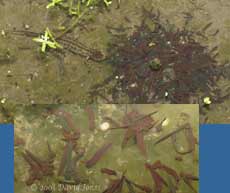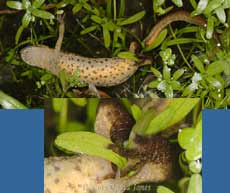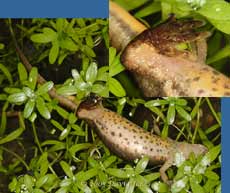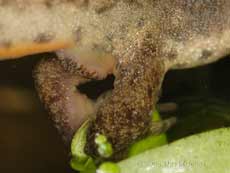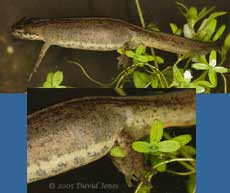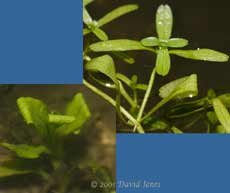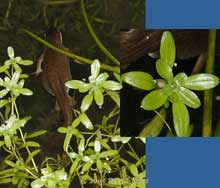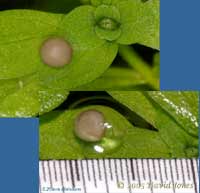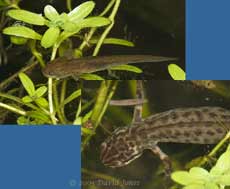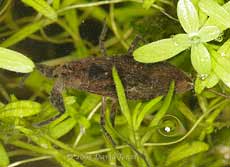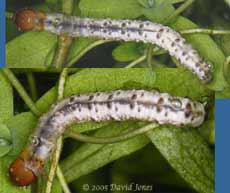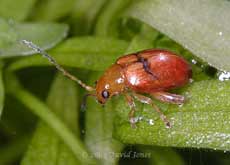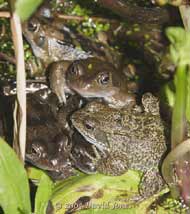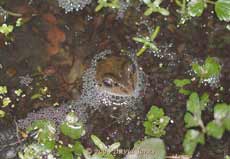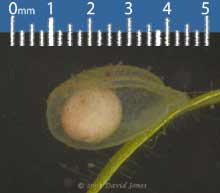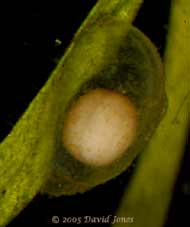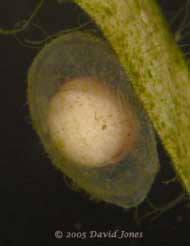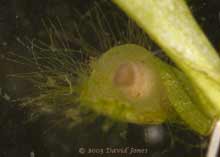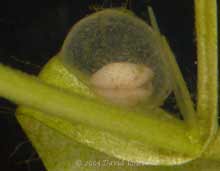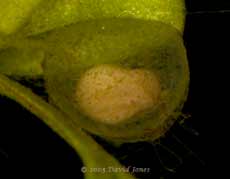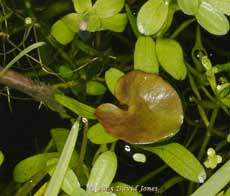Go to last entry on this page....................Go to previous entry1 April - Over the last few nights I have seen several female news egg-laying, but I haven't been able to get any new pictures.
Many are still gathered together in large groups which act as magnets to hungry newts, especially after dark. It's always interesting to see the range of colours amongst the tadpoles, as shown in these pictures.
4 April - Last night, after 9pm, I settled down by the pond to watch out for newt activity and was rewarded by the nearest I've seen to a mass spawning by the newts in my ponds. There were a couple of dozen newts of both sexes in one corner of the pond, around a clump of Water Starwort that is growing fast.
However, once in a while one would choose a more open spot. While they usually stayed the 'right way up' this one chose to roll over in her efforts to attach an egg to the underside of a small leaf. Once in this position, her front legs were left to hang in the water as the hind legs wrapped the leaf around the egg as it emerged (out of sight of the camera!)
The newt would stay in this position for a couple of minutes before moving away. About ten minutes later I photographed what I thought was another newt in a similar posture. It wasn't until I looked at the images on the computer this morning that I realised that it was the same newt as pictured above.
As well as the newts egg laying in the mass of the Starwort, other individuals, like this one, were busy around the edges. It was fascinating to watch as she chose a leaf. She would swim up to the plants first, and then turn away, waving about her hind legs until they came in contact with the plant. She then attempted to grip the leaf firmly, and if she couldn't succeed fairly quickly she would swim off and try elsewhere.
In the lower-left image you can see larger leaves below the surface that have already been used in this way. In the top-right image, while one Starwort leaf has been folded over (lower-right), the leaf to its left is only partially bent, and you can just see an egg underneath it.
Considering that the newt lays her eggs 'blind', as it were, it's not surprising that sometimes the egg doesn't end up hidden. underneath a leaf. In this shot you can see a newt suspended in open water as she lays an egg, and to her right you can see an egg laid earlier, near the base of a leaf, and on top of it.
This egg is even more exposed, very close to the side of the pond. The top image was taken last night, shortly after it was laid. The lower image, taken this morning, shows that cell division has begun (possibly four cells at this point?). The scale, floating on the water next to it, shows that the egg is about 1.25mm across, with an albumen jelly protective sphere of around 2.5mm diameter.
While the females were all busy, the males were always in close attendance usually around edges of the Starwort. Also in the middle of the action were several of the young newts. It's curious to ponder whether these are watching Brothers, sisters, half-sisters, or cousins being produced around them! Will they be mature enough to be part of the process next Spring?
It will feed on any small creature, including the young newts when they emerge, although I don't know if they will eat the eggs. I think they are more interested in prey that moves.
7 April - I've been too tired to do any night-time pond watching the last couple of days, but I can confirm that egg laying is continuing today, in daylight. I spent a bit of time by the pond between the heavy showers we've been getting today. The newts are very active, although the reflections of the sky make it difficult to see things clearly. However, I caught sight of the largest male newt I have ever seen in the pond. There was no chance of a photograph, but it was much bigger than any of the other males and its crest was much more pronounced. I'm not going to get too excited at this point - it may just be a more mature male than the others in the pond, but I will be watching out for it in the days to come.
While I watched the newts I spotted this larva seemingly feeding on the Starwort, about an inch under water. It was about 20mm long. I can only speculate that it is the larva of a beetle.
Also, I found two small orange coloured beetles floundering on the pond surface. As I rescued them, one jumped a matter of nearly six inches into the undergrowth of the pond bank. Fortunately this one stayed on the pondweed long enough be photographed. They are obviously flea beetles, possibly
Ragwort Flea Beetles (Longitarsus flavicornis) which I have seen
during August in previous years (recorded in the garden diary) The black line across its back seems to be some sort of damage rather than a marking. While I was lying down to take these pictures a large Water Scorpion suddenly appeared right in front of me, not in the water, but on land, but heading back into the pond, probably having been disturbed (and almost squashed!) by me.
It continues to puzzle me why they gather in groups like this one, and stay in place for hours on end, even with another frog's foot on ones face.
The bubbles are being produced as the tadpoles gulp air at the surface, having already lost their external gills.
The frog's pointy snout indicates that it is a young one that wouldn't have been involved in spawning this Spring. There are numerous of these in the pond, probably having developed from spawn in this pond, and which will form the basis of future generations here. At night, many of the newts continue to congregate in the shallow end to feed on the smaller tadpoles, although some are now too big to fall victim to the predators. At the other end of the pond egg-laying continues. It's amazing to compare the newts with the frogs. While the female frogs produces all her spawn, anywhere between 1000-4000 eggs! On the other hand, a Common (Smooth) Newt female lays up to 400 eggs - just one egg at a time, from 7 to 12 eggs each day. This means that it can take up to nearly two months to complete her task, with the first eggs hatching out after about 2-3 weeks, long before mum has finished. I have started to take some close-up images to try and show progress in the development of the eggs. I hope to get a more 'complete' set of photographs over the next few weeks, but in the meantime, I'll put some images into the diary either tonight or tomorrow -
14 April - As promised, here is a sequence of images that I hope will convey an idea of how the newt eggs are progressing in my pond. The images are of different eggs, and image quality is mixed, partly due to the algae that grow around the outside of the eggs' albumen layers.
For me, the most interesting feature revealed in this image is the thickened 'collar' that the albumen ball has. It seems that it is this collar that attaches the egg to the plant, something I hadn't realised previously.
One of the first visible signs that the newt embryo is starting to develop specialised areas is when a darker band starts to appear on what will be the dorsal (top) surface of the animal. This is just visible in this image, running parallel to the leaf. It marks the development of the neural plate, which will later become the spinal cord and brain of the newt.
In this image the band is much more obvious
(down the right side of the egg), and you can already see that a depression
is forming along it, most easily seen at the top of the embryo.
Here you can see it from above, and this
shot clearly shows how the tissues either side of the plate are starting to
form ridges (neural folds) that will gradually fold over, and cover it.
This shot shows the 'head end' of the embryo, again showing the ridges around the darker neural plate. You have to look through much more algal growth to see this one.
In this embryo the neural plate is almost completely enclosed by the folds, and you can see how the thick folds at the head end (right of image) are elongating the embryo's shape.
In the meantime, this picture shows an embryo in which the neural plate is now completely covered by the ridges which have fused together to form a line along the back of the embryo and have given it a definite head end.
I'll be looking out for more examples to add to this series of images over the next few weeks. On the plant front, pond plants are thriving now, with the patches of Starwort spreading quickly. At some point I will have to remove some of it. That will be delayed as long as possible, certainly until I can detect no more eggs on it, as it will involve a lot of careful checking to prevent killing the young newts and other creatures.
Notice yet another newt egg at the top of the image.
Click on an image to see
a larger version |
|
